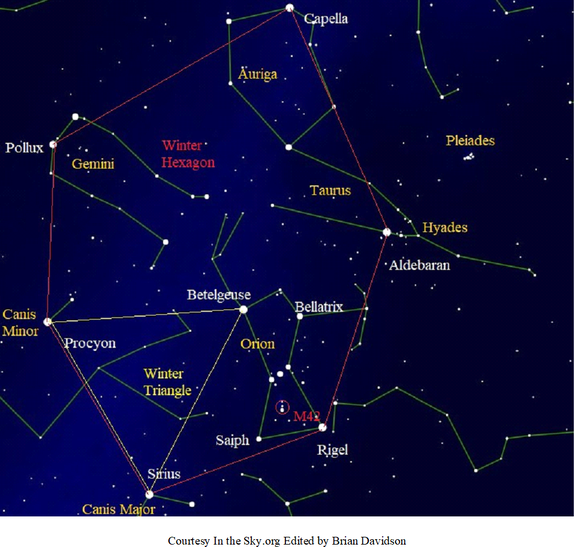|
The weather hasn’t been very kind to us recently so let’s hope there are clear skies ahead so that we can enjoy the winter sky. I failed to observe the daytime occultation of Venus by the Moon in November due to cloud cover but the Moon and Jupiter looked good together at the end of the month. Observing The following chart represents the night sky at 10.00pm GMT on the 8th of December and at 9.00pm GMT on the 23rd December. To use the chart, face your southern horizon at the appropriate time and you will see the stars in the chart. This month the constellation Orion- The Hunter is the focus of our attention and no signposts are required to find it because it stands out so much on its own. However last month we looked at the constellations Auriga and Taurus and they are to the top and right of the chart so it should look familiar.
It doesn’t take much to visualise a hunter from the stars in Orion and even the less bright ones are quite distinctive. Orion’s right shoulder is represented by the star Betelgeuse, a variable red supergiant varying in magnitude from about 0.3 to 1.2 and the 7th brightest star in the northern hemisphere. It has the potential of going supernova at any time but I’ve probably said that in several blogs so don’t expect it to happen right away. It caused a bit of a stir recently when it dimmed more than usual but apparently that was due to an ejection of dust. An even brighter star Rigel, a blue supergiant of magnitude 0.2 represents Orion’s left foot. Bellatrix and Saiph are the two remaining stars which outline the body shape. Between these pairs of stars is a line of three stars going from south-east to north-west and they represent Orion’s belt and at a magnitude of around 2 they really stand out and give Orion an unmistakable appearance. Less bright but still visible to the unaided eye is Orion’s sword hanging from his belt. The bottom star of the sword should be visible in good conditions and above this is a fuzzy patch which is the much celebrated Orion nebula (aka M42) where star formation is taking place. Try to observe it through binoculars or a telescope if you get the chance. Orion is a good starting point for making your way around the winter sky and if you follow a line from Orion’s belt to the upper right just below Bellatrix and beyond, you find the red giant star Aldebaran in Taurus. Continue the line beyond Aldebaran and you find the star cluster- The Pleiades. Having followed the line to the Pleiades turn ninety degrees to the left and you find the bright star Capella in the constellation Auriga, lying directly above Taurus. It is the 4th brightest star in the northern hemisphere at magnitude 0.1. Now follow Orion’s belt in the opposite direction and you find the brightest star in the night sky, Sirius- the Dog Star in the constellation Canis Major- the Greater Dog. At magnitude -1.4 it is twenty three times more luminous than the Sun and a mere 8.6 light years distant. Sirius is part of the asterism, the Winter Triangle (outlined in yellow on the chart), formed in conjunction with Betelgeuse and Procyon. The latter is east of Betegeuse in the constellation Canis Minor- the Lesser Dog and shines at magnitude 0.4. Finally we have another asterism, the Winter Hexagon (outlined in red on the chart), roughly centred on Betegeuse and comprising the stars Sirius, Rigel, Aldebaran, Capella, Pollux and Procyon. You can enjoy these over the coming months as they travel westwards in the evening sky. Something to look out for If like me you failed to see the daytime occultation of Venus by the Moon last month, you have a chance for the next best thing when there is a close approach of the Moon and Venus on the morning of Friday 9th December. Jupiter has been bright in the sky on clear evenings and on Friday 22nd December it has a close approach with a ten days old Moon. Of course the December solstice occurs on the same day. Hopefully there will be plenty of opportunities to enjoy the winter skies. Clear skies.
0 Comments
|
AuthorWMA members Archives
July 2024
Categories |
Proudly powered by Weebly


 RSS Feed
RSS Feed